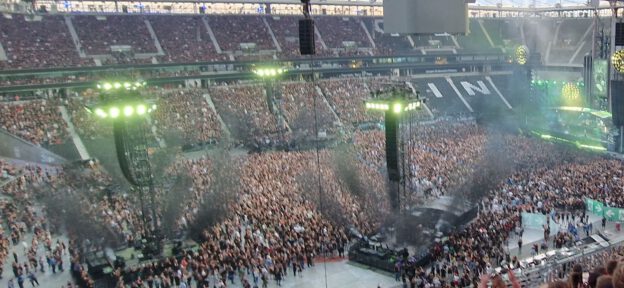

KW-29-2024: unanswered questions …

KW-29-2024: Der Countdown läuft: LIEDER AM SEE – FESTIVAL 2024 am 27.7.2024
Classic Rock am Strandbad
TICKETS & INFOS:
https://www.liederamsee.com/das-festival.html
Vor über 30 Jahren fiel der Startschuss für das Fränkische Seenland. Seither ist eine wertvolle Freizeitlandschaft südlich von Nürnberg entstanden. Der große Brombachsee ist das Herzstück im Seenland. Die dortige Freizeitanlage mit dem Strandbad in Spalt-Enderndorf am Nordufer bietet nahezu perfekte Voraussetzungen für ein schönes Sommerfestival.
Nach dem wachsenden und inzwischen großen Erfolg der letzten Jahre und dem fulminanten Auftritt der Legenden DEEP PURPLE 2022 feiert das Festival am Samstag, den 27.07.2024 seine zwölfte Auflage. Unter dem Titel LIEDER AM SEE gastieren namhafte Künstler, die sich ihren Platz im Rockolymp längst gesichert haben.
Headliner ist dieses Mal SUZI QUATRO. Mit EUROPE, MANFRED MANN’S EARTH BAND, LEVEL 42, WISHBONE ASH und BIG COUNTRY wird auch das weitere Programm hochkarätig besetzt sein.

KW-29-2024: Der Countdown läuft: Am Sonntag spielt Marillion-Gitarrist Steve Rothery bei The Final Night of the Prog Festival auf der Lorelely vom 19.-21. Juli 2024
Mehr INFOS über Marillion und Steve Rotherey im Buch und im dortigen Kapitel: I. Book Of Marillion

KW-29-2024: BOB DYLAN gab heute die Tourdaten für die kommende Europatournee im Herbst bekannt. VVK ist am Freitag, den 19. Juli 2024
KW-29-2024: Bob Dylan kommt nach Saarbrücken – Damit tritt er zum 4. Mal in der saarländischen Hauptstadt auf.

KW-29-2024: AUF DER SUCHE NACH LEONARD
Patrick Page und Perla Batalla: Auf der Suche nach Leonard
21. September 2024
Tickets sind seit Freitag im VVK: Erfahren Sie hier mehr über den Zugang zu Vorverkäufen.
Begleiten Sie dem fesselnden Duo Patrick Page und Perla Batalla, während sie die Bühne mit einer elektrisierenden Feier von Leonard Cohens dauerhaftem Vermächtnis entzünden. In einem seelenberührenden Abend mit Musik, Poesie und persönlichen Anekdoten ehren sie den tiefgreifenden Einfluss von Cohens Genie auf ihr Leben und ihre Karriere.
Die Grammy-nominierte Kraftpaket Perla Batalla, einst ein geschätztes Mitglied von Leonard Cohens innerem Kreis, verzaubert das Publikum mit ihrem samtigen Gesang und intimen Reflexionen. Batallas Konzert-Hommage an ihren Mentor, In Cohens Unterstützerin, die aus Cohens Backing-Sängerin zu einer weltweit gefeierten Künstlerin mit sieben eigenen Alben aufblühte, setzt sich fort, die ausverkauften Massen weltweit zu fesseln. Ihr zweites Album, das Cohens Repertoire gewidmet ist, wird dieses Jahr veröffentlicht.
Währenddessen durchdringt der Grammy-prämierte Virtuose Patrick Page, der für seine magnetischen Auftritte am Broadway gefeiert wird, Cohens Melodien mit einer ergreifenden Tiefe, die aus seiner eigenen Ehrfurcht vor dem ikonischen Troubadour entstanden ist. Bekannt für seine Tony®-nominierte Darstellung von Hades in Hadestow n und seine facettenreichen Rollen in 15 Broadway-Produktionen und zahlreichen Filmen und Fernsehsendungen, wurde Pages Stimme häufig mit Cohens Stimme verglichen.
Auf der Suche nach Leonard navigieren und Batalla zärtlich durch einen Wandteppich persönlicher Anekdoten und geschätzter Erinnerungen navigieren und sich mit einem dynamischen Ensemble vereinen, um seelenrührende Interpretationen von Cohen-Klassikern wie „Hallelujah“, „Bird on a Wire“, „I’m Your Man“, „Suzanne“ und „So Long, Marianne“ zu liefern.
Diese Premiere ist der Beginn einer Reise, die dazu bestimmt ist, die Welt zu durchqueren und ein unvergessliches Erlebnis für die Anhänger von Leonard Cohen, Patrick Page und Perla Batalla gleichermaßen bietet. Verpassen Sie nicht die Gelegenheit, in die zeitlose Magie von Cohens Vermächtnis einzutauchen, die von zwei außergewöhnlichen Talenten zum Leben erweckt wurde.
ENGLISH VERSION:
Join the captivating duo of Patrick Page and Perla Batalla as they ignite the stage with an electrifying celebration of Leonard Cohen’s enduring legacy. In a soul-stirring evening of music, poetry, and personal anecdotes, they honor the profound impact of Cohen’s genius on their lives and careers.
Grammy-nominated powerhouse Perla Batalla, once a cherished member of Leonard Cohen’s inner circle, enchants audiences with her velvety vocals and intimate reflections. Having blossomed from Cohen’s backing vocalist to a globally acclaimed artist with seven albums in her own right, Batalla’s concert-homage to her mentor, In the House of Cohen, continues to captivate sold-out crowds worldwide. Her second album devoted to Cohen’s repertoire will be released this year.
Meanwhile, Grammy-winning virtuoso Patrick Page, celebrated for his magnetic performances on Broadway, infuses Cohen’s melodies with a poignant depth born from his own reverence for the iconic troubadour. Known for his Tony®-nominated portrayal of Hades in Hadestown and his multifaceted roles across 15 Broadway productions and numerous films and television shows, Page’s voice has frequently been compared to Cohen’s.
In Looking for Leonard Page and Batalla tenderly navigate through a tapestry of personal anecdotes and cherished memories, uniting with a dynamic ensemble to deliver soul-stirring renditions of Cohen classics like “Hallelujah,” “Bird on a Wire,” “I’m Your Man,” “Suzanne,” and “So Long, Marianne.”
This premiere event marks the beginning of a journey destined to traverse the globe, offering an unforgettable experience for devotees of Leonard Cohen, Patrick Page, and Perla Batalla alike. Don’t miss the opportunity to immerse yourself in the timeless magic of Cohen’s legacy brought to life by two extraordinary talents.

KW-28-2024: Gott weiß, ich will kein Engel sein : Im Vorprogramm von Rammstein – Klaviermusik von ABÉLARD.

KW-28-2024: zurück von Frankfurt – Tag 1 von 3 : 11. Juli 2024
photo: Christof Graf
Setlist:
Music for the Royal Fireworks (George Frideric Handel song)
Ramm 4
Links 2-3-4
Keine Lust
Sehnsucht
Asche zu Asche
Mein Herz brennt
Puppe
Wiener Blut
Zeit
Deutschland
(Remix by Richard Z. Kruspe)
Deutschland
Radio
Mein Teil
Du hast
Sonne
Encore:
Engel
(with ABÉLARD) (Piano version; performed on B-Stage)
Ausländer
Du riechst so gut
Pussy
Ich will
Encore 2:
Rammstein
Adieu
Sonne
(Piano version)
Haifisch
(Haiswing Remix by Olsen Involtini)
Lügen
(Instrumental)

KW-28-2024: zurück von Frankfurt – Tag 2 von 3
photo: Christof Graf


